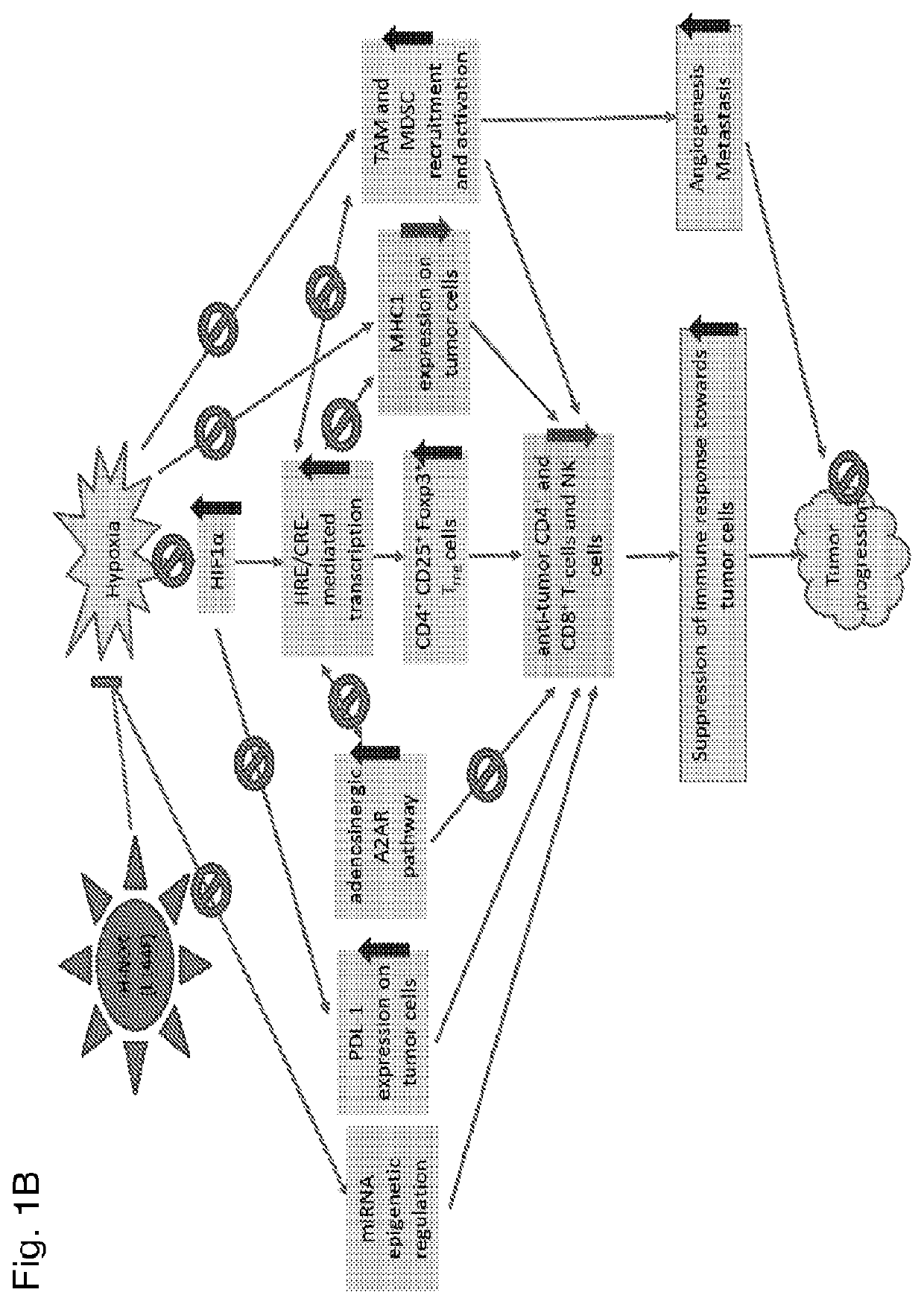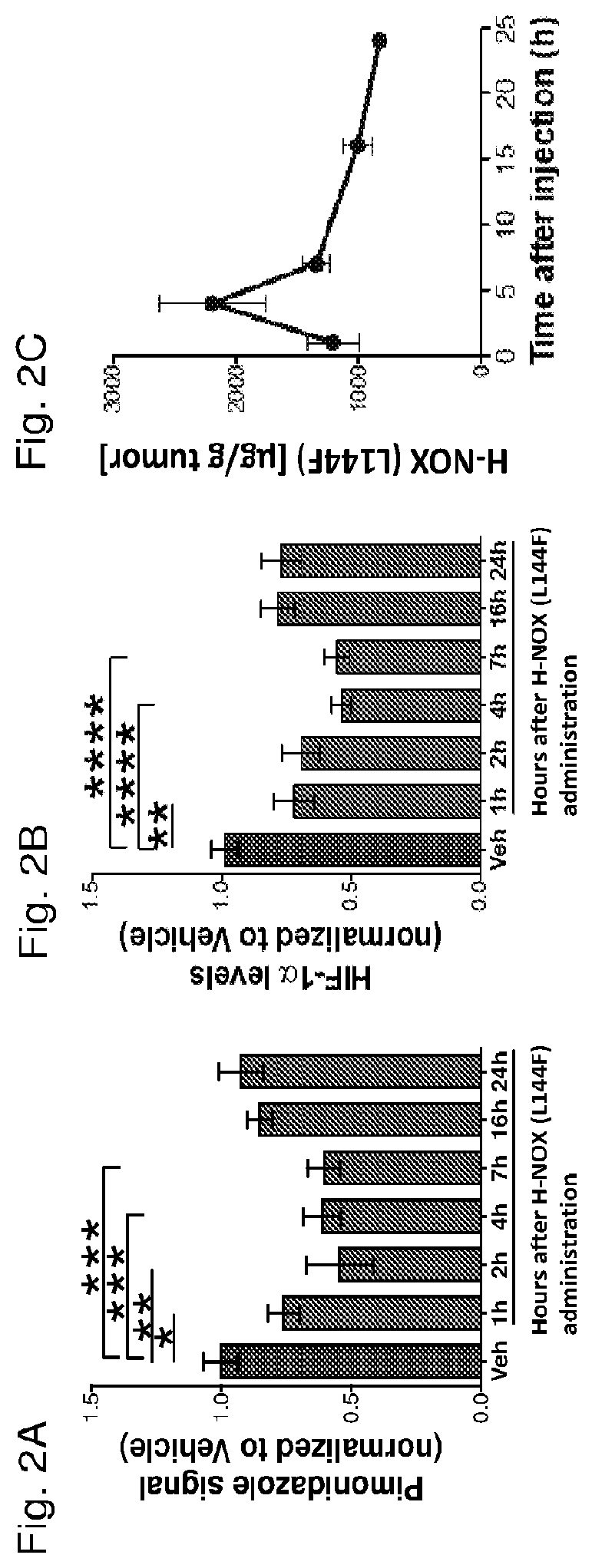Modulation of tumor immunity by protein-mediated o2 delivery
a tumor immunity and protein-mediated technology, applied in the field of tumor immunity modulation, can solve the problems of limiting the penetration depth of hypoxic tumor tissue, and achieve the effects of enhancing the immune response to the tumor, increasing lymphocyte infiltration, and modulating tumor immunity
- Summary
- Abstract
- Description
- Claims
- Application Information
AI Technical Summary
Benefits of technology
Problems solved by technology
Method used
Image
Examples
example 1
bles Efficient Oxygenation of Hypoxic Tumor Microenvironments
[0227]A PEGylated trimeric Thermoanaerobacter tengcongensis (Tt.) H-NOX bearing a L144F substitution in the distal pocket (FIG. 6B) was evaluated for the ability to oxygenate tumor microenvironments and increase radiation sensitity. Administration of the PEGylated trimeric Tt H-NOX L144F to mice bearing hypoxic tumors induces rapid and sustained oxygenation of the tumors as directly measured by the external hypoxia marker, pimonidazole, hypoxia inducible transcription factor 1 alpha, HIF-1-α, and OxyLite oxygen-sensing nanofiber (FIGS. 2 and 3, respectively).
[0228]Mice hearing H460 subcutaneous xenograft tumors were injected i.v. with PEGylated trimer H-NOX (L144F) at 650 mg / kg when tumor volume reached ˜300-350 mm3 (˜10-14 days after tumor cell subcutaneous implantation). Prior to euthanasia, mice were injected with the exogenous hypoxia marker pimonidazole at 60 mg / kg and tumors were harvested. Pimonidazole (FIG. 2A) (Hy...
example 2
s as an Immunoactivator Enhancing Host Anti-Tumor Responses
[0236]PEGylated trimer Tt H-NOX L144F-induced oxygenation inhibits the HIF-1α pathway (FIG. 2B) and relieves HIF-1α-dependent and HIF-1α-independent tumor immunosuppression. Mice hearing H460 subcutaneous xenograft tumors (200-350 mm3) were either treated with vehicle alone or with PEGylated trimer H-NOX (L144F) and harvested 7, 16 or 24 hours after injection for qRT-PCR analysis. Mean values+ / −SEM. N=5-6 per group, *p<0.05 by t-test. Treatment with a single dose of H-NOX resulted in significant downregulation of HIF-1α and its effectors including direct and indirect modulators of the host's immune response: PD / PDL-1 and VEGF signaling, metabolic and growth factor regulators (FIG. 5).
[0237]Seven to eight week old Nu / Nu female mice were subcutaneously implanted with 3×106 of H460 human lung cancer cells and monitored until the tumors reached average size of ˜300 mm3 (10-14 days post-implantation of tumor cells). Mice bearing ...
example 3
nt of Hypoxia and T Cells in 1316F10 and CT26 Subcutaneous Tumors and Intracranial GL261-Luciferase Tumors
[0240]Generation of B16F10 and 0726 subcutaneous tumors and intracranial GL261-luciferase tumors. Six to eight week old C57BL / 6J female mice were subcutaneously implanted with 1×106 B16F10 mouse melanoma cancer cells on the Clank (FIG. 7A). Six to eight week old BALB / c female mice were subcutaneously implanted with 1×106 CT26 colon tumor cells on the flank (FIG. 7B). Male C57BL / 6J weighting 20 g were injected with 3×105 GL261-luc cells intracranially into the right caudate nucleus (+0.5 mm. A / P, +2.3 mm M / L and −3.2 mm. D / V) (FIG. 7C). Intracranial tumors were allowed to grow for 21 days before sacrifice. Subcutaneous tumors were measured 3 times a week using calipers and tumor size was calculated based on the formula: (length×width2)÷0.5. Once the tumors reached an average size of ˜300 mm3 (10-14 days post-implantation of tumor cells), treatment was initiated.
[0241]Treatment. M...
PUM
| Property | Measurement | Unit |
|---|---|---|
| molecular weight | aaaaa | aaaaa |
| molecular weight | aaaaa | aaaaa |
| O2 dissociation constant | aaaaa | aaaaa |
Abstract
Description
Claims
Application Information
 Login to View More
Login to View More - R&D
- Intellectual Property
- Life Sciences
- Materials
- Tech Scout
- Unparalleled Data Quality
- Higher Quality Content
- 60% Fewer Hallucinations
Browse by: Latest US Patents, China's latest patents, Technical Efficacy Thesaurus, Application Domain, Technology Topic, Popular Technical Reports.
© 2025 PatSnap. All rights reserved.Legal|Privacy policy|Modern Slavery Act Transparency Statement|Sitemap|About US| Contact US: help@patsnap.com



